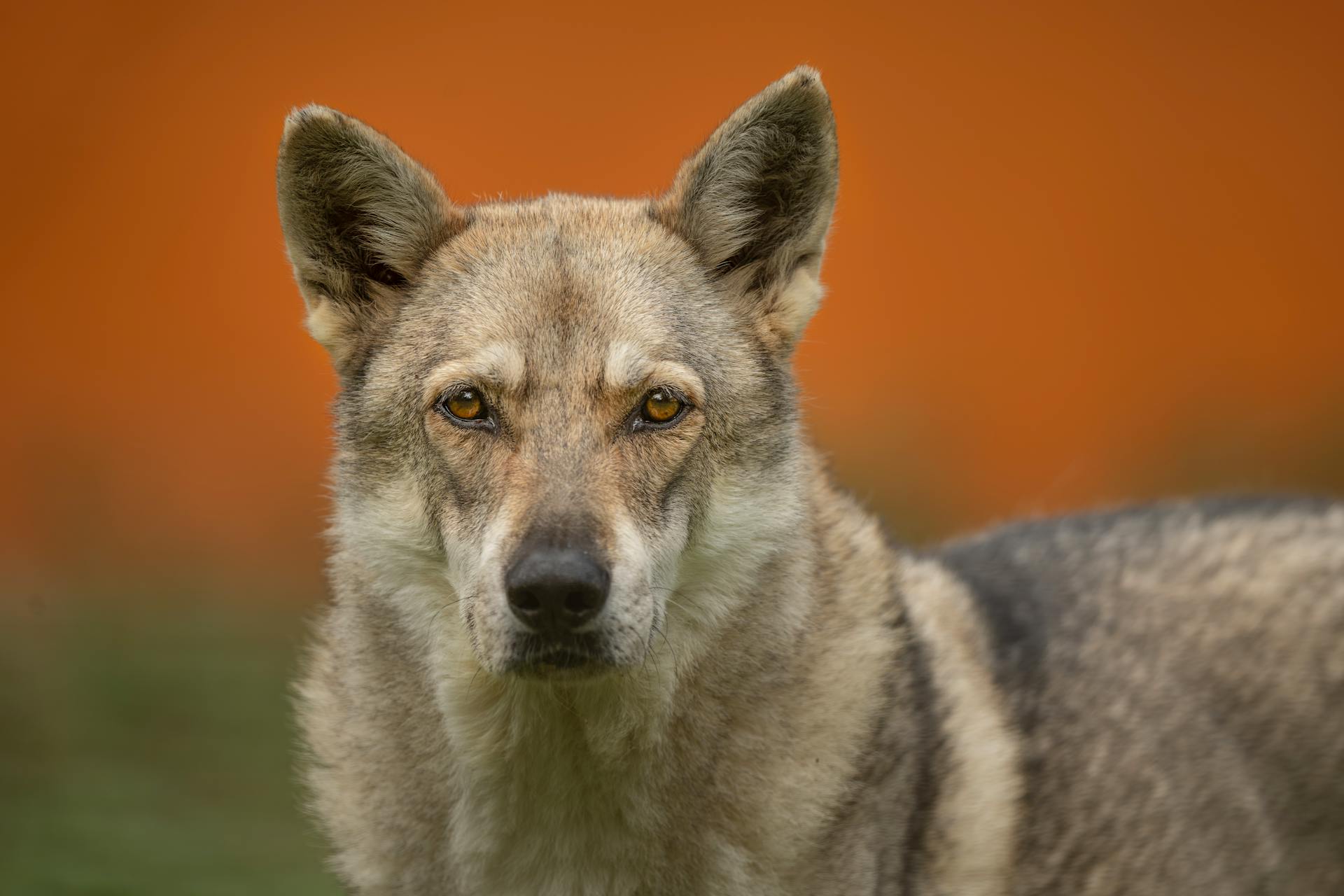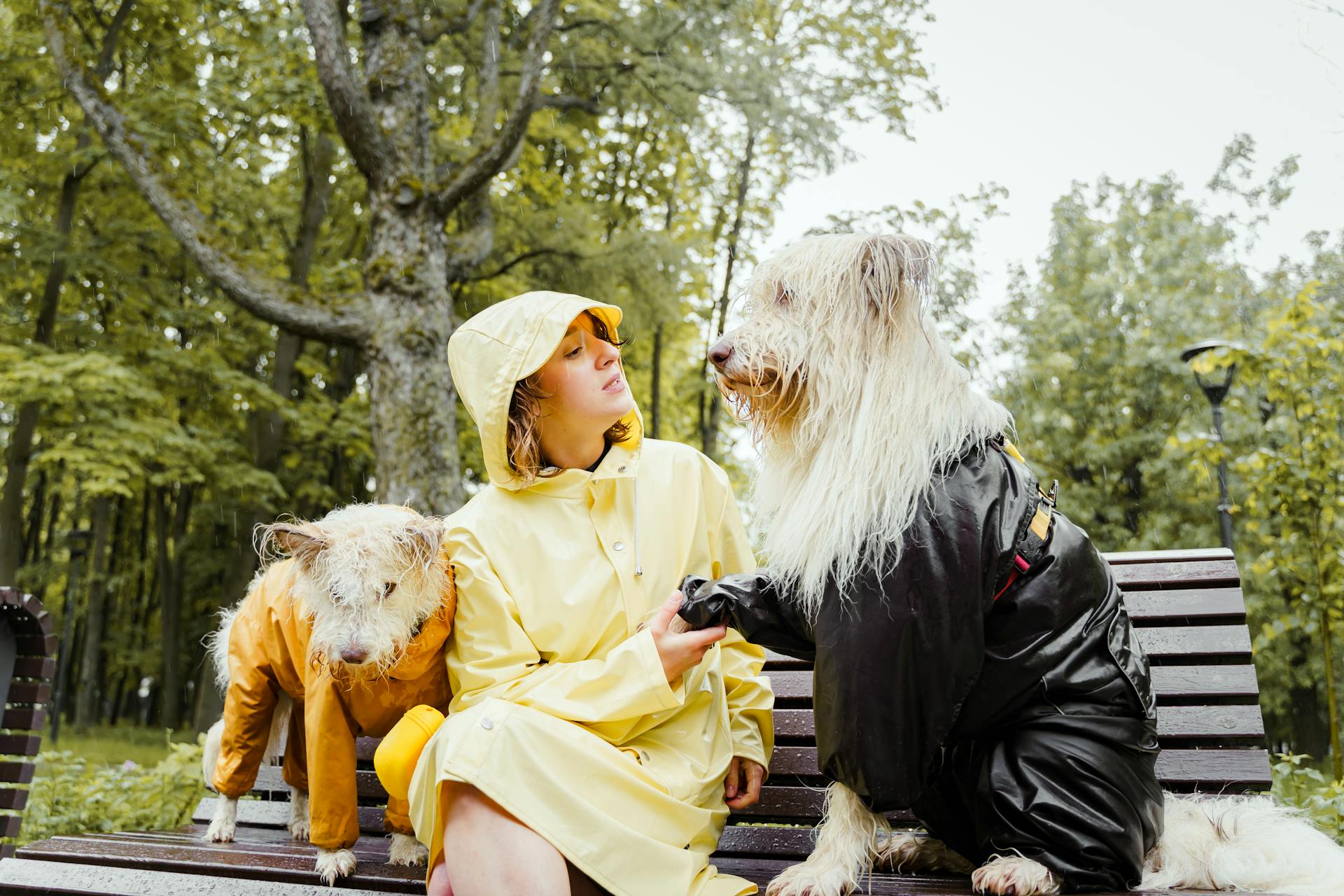
Adopting a Czechoslovakian Wolfdog can be a life-changing experience, but it's essential to understand the unique needs and characteristics of this breed.
Czechoslovakian Wolfdogs are a cross between a German Shepherd and a Carpathian Wolf, resulting in a highly intelligent and energetic dog that requires regular exercise and mental stimulation.
They are naturally wary of strangers and may take time to warm up to new people and environments.
Czechoslovakian Wolfdogs are highly trainable, but they require a firm and consistent hand, as they can be strong-willed and independent.
Their thick double coat sheds heavily, especially during shedding season, so be prepared for regular grooming and vacuuming.
With proper care and attention, Czechoslovakian Wolfdogs can thrive in a variety of living situations, from apartments to homes with yards.
Explore further: Minnesota Wolfdogs
Breed Characteristics
The Czechoslovakian Wolfdog is a breed that's naturally suspicious of strangers, so proper socialization is key to helping them feel comfortable around new people. This wariness can be a challenge if not addressed.
Their loyalty to their families is unwavering, making them great companions for those who are willing to invest time and effort into building a strong bond.
Here's a summary of the breed's characteristics:
Vlcak History
The Czechoslovakian Vlcak has a rich history dating back to 1955, when Karel Hartl crossed a German Shepherd Dog with a Carpathian Wolf in a biological experiment in the CSSR.
This unique pairing led to the creation of a powerful breed with exceptional senses and incredible stamina. Some Vlcaks have even completed endurance tests in which they ran 100 km in eight hours!
The Vlcak was first bred in the 1950s as an experiment to combine the qualities of the wolf and dog into one breed. The goal was to create a border guard dog with the endurance, resistance to adverse conditions, scent, sight, and hearing of the wolf.
The Vlcak became the country's national breed in 1982, and the United Kennel Club recognized the breed in 2006.
Broaden your view: Czech Wolfdog Puppy
Appearance
The Czechoslovakian Wolfdog is a striking breed with a wolf-like appearance. Their height can reach up to 28 inches and weigh up to 90 pounds.

Their body length is similar to their height, making them a medium to large breed. Their straight and strong spine supports a short and slightly sloped back.
Their chest is large and flat, leading to a drawn-in belly. Their tail is bushy and set high above their muscular legs.
Their ears stand upright and are short and triangular in shape. Their eyes are amber, sitting above strong and scissor-shaped jaws.
Their thick and straight fur has a double coat, which is thin and short in summer and thick and long in winter. Their coat can be yellow-gray or silver-gray with a light mask and a black muzzle.
Broaden your view: Large Münsterländer
Vlcak Traits
Czech Vlcaks have strong jaws, triangular, pricked ears, and amber-colored eyes that will confidently size you up.
Their rectangular bodies are muscular, and their tails hang straight down when at rest.
They're highly intelligent and hard working, but also incredibly independent and can be dominant.
They can lose motivation and get bored very easily, especially if forced to perform the same exercise repetitively.
They need to see a purpose for the task and will benefit from positive reinforcement.
Their loyalty to their owner is unmatched, but they can be suspicious of strangers and are alert, making them great guard dogs.
They're actually quite quiet dogs and do not usually bark.
They can behave well and become affectionate around children if introduced correctly, but proper socialization as a puppy is crucial.
They can become aggressive if not shown proper authority, so leadership is key when training this breed.
Temperament & Intelligence
The Czechoslovakian Wolfdog is a highly intelligent breed, known for its keen awareness of its surroundings. They can learn moderate and simple commands, but may not be as easy to train as their German Shepherd parents.
Their intelligence is matched by their independence, which can make them difficult to train if not approached correctly. They need to see a purpose for the task, and positive reinforcement is key.
A unique perspective: How to Train a German Shorthaired Pointer to Hunt
Czechoslovakian Wolfdogs are naturally suspicious of strangers, which can make them great guard dogs. However, this wariness can be a problem if not socialized properly from an early age.
Here's a breakdown of the breed's temperament and intelligence:
Their loyalty to their families is unwavering, but this can also make them protective and alert. Early socialization is crucial to help them develop into well-mannered companions.
Vlcak Traits
Czech Vlcaks have strong jaws, triangular, pricked ears, and amber-colored eyes that will confidently size you up.
Their rectangular bodies are muscular, and their tails hang straight down when at rest.
One thing to keep in mind is that Czechoslovakian Wolfdogs can be quite quiet dogs and do not usually bark.
Their loyalty and alertness make them great guard dogs, but they can also be suspicious of strangers and other animals.
Weight
Vlcaks are known for their athletic build, and their weight is a key factor in their overall health and well-being.
On average, a healthy adult Vlcak weighs between 50-70 pounds (23-32 kg).
Their weight can vary depending on their lineage and overall health, but this range is generally considered ideal.
Vlcaks with a higher weight tend to be less agile and more prone to joint issues.
However, Vlcaks that are underweight can be more susceptible to illness and may not be as energetic.
A well-balanced diet and regular exercise can help maintain a healthy weight for your Vlcak.
Suggestion: Black Czech Wolfdog
Distinctive Physical Traits
The Czech Vlcak's physical traits are truly distinctive. Their strong jaws are a notable feature, perfect for tackling tough tasks.
Their triangular, pricked ears are always perked up, as if listening for any sign of excitement. A characteristic that's both functional and adorable.
Their amber-colored eyes are a deep, rich color that seems to size you up with confidence. It's as if they're saying, "I know exactly what you're thinking."
Their rectangular bodies are muscular and athletic, built for agility and endurance. You can see why they're a popular choice for active families.
Their tails hang straight down when at rest, a subtle but endearing detail that adds to their charm.
For another approach, see: Dogs Breeds That Start with B
Vlcak Temperament
The Czech Vlcak is a high-energy dog that's known for its intelligence and courage. They're extremely loyal to their families and make devoted companions.
Their dominant and independent personalities can make them challenging for first-time pet parents. Early socialization is crucial to help your Vlcak develop into a well-mannered companion.
Czech Vlcaks are naturally protective and watchful, making them good guard dogs. They can be suspicious of strangers, so it's essential to socialize them properly.
Their strong prey drive means they might pursue small animals, so it's crucial to keep a close eye on them.
Readers also liked: Czech Mountain Dog
Care and Maintenance
The Czechoslovakian wolfdog is a low-maintenance breed that rarely needs a bath due to its weather-resistant coat and minimal body odor.
They do shed heavily year-round, with heavier shedding occurring twice a year. You'll need to brush them frequently, especially during the winter months when their coat is thicker.
Regular brushing can help manage shedding, but be prepared for a layer of fur to cover your home - they're not hypoallergenic.
To keep your Czechoslovakian wolfdog looking and feeling its best, trim their fast-growing nails regularly and clean their ears weekly. Brushing their teeth two to three times a week is also essential for their dental hygiene.
Diet and Nutrition
Czechoslovakian Wolfdogs need a diet formulated for their life stage, such as puppy, adult, or senior. A food made specifically for large breeds will have the right balance of nutrients for their size and activity level.
To avoid overfeeding, use a measuring cup to portion out their meals. Keeping treats to no more than 10% of their daily calories is also essential.
High-quality, calorie-dense performance diets are recommended for highly active and athletic Czechoslovakian Wolfdogs. Working dogs and canine athletes require these specialized diets.
Feeding measured meals twice a day, rather than free feeding, will help prevent weight gain and associated health problems. Excess weight can contribute to issues like hip dysplasia and diabetes.
A raw food diet is highly recommended for Czechoslovakian Wolfdogs, as they are closely related to wolves and have a natural inclination towards a carnivorous diet.
Take a look at this: Best Food for Rhodesian Ridgeback
Grooming
The Czechoslovakian Wolfdog's coat is naturally weather-resistant, requiring only occasional baths.
They have very little body odor, making them a low-maintenance dog in terms of grooming.
Brushing is essential to manage their heavy shedding, which occurs year-round.
In the winter, their coat is thicker, so they'll need more frequent brushing to prevent matting.
Twice a year, they'll experience dramatic shedding, also known as "dropping coat" or "blowing coat", and daily brushing will be necessary during these periods.
Frequent brushing can help manage shedding hair, but be prepared for a layer of fur to cover your home.
To keep their coat looking beautiful, occasional baths and weekly nail trimming are a must.
It's also essential to check and clean their ears weekly, using a pet-safe ear cleaner when necessary.
Brushing their teeth two to three times a week is crucial for their dental hygiene.
To make grooming easier, acclimate your Czechoslovakian Wolfdog to brushing from an early age, so they become comfortable with the process.
Having multiple grooming tools on hand, such as bristle brushes and nail clippers, will make grooming a breeze.
Related reading: Will Shiba Inu Coin Reach $1
Exercise
Czechoslovakian Wolfdogs need a lot of daily activity and mental stimulation to thrive. They can run up to 100 km if they have to, so they require plenty of exercise to keep them happy and healthy.
You'll need to give your dog at least two hours of exercise a day, including walks and playtime, to help it thrive. This can be achieved through activities like hiking, running, and playing retrieving games.
These dogs can roam several miles a day, so they need a very secure, fenced-in backyard to prevent them from running away or getting into trouble. Keep your wolfdog on a leash anytime they aren't in a secured space.
Czechoslovakian Wolfdogs can be reserved and resistant to new faces, so introducing them to other dogs can be challenging. They may not make very good candidates for dog parks, especially if they're not socialized properly.
Related reading: When Is National Boston Terrier Day
Health and Well-being
The Czechoslovakian Wolfdog is a generally healthy and robust breed. However, like all breeds, they can be prone to certain health issues.
One thing to be aware of is elbow dysplasia, a skeletal growth abnormality that can cause lameness in the forearms. Hip dysplasia is another common issue, where the hip joint develops abnormally.
For another approach, see: Bernese Mountain Dog Hip Dysplasia

In addition to these joint issues, the breed can also be prone to eye problems, including lens luxation, a condition where the lens of the eye becomes dislocated.
Degenerative myelopathy is a serious health issue that affects the white matter of the spinal cord, causing lameness of the hind limbs. Exocrine pancreatic insufficiency is another health concern that can affect the breed.
Here's a list of some of the common health issues to be aware of:
- Elbow Dysplasia
- Hip Dysplasia
- Lens Luxation
- Exocrine Pancreatic Insufficiency
- Degenerative Myelopathy
It's essential to have your Czechoslovakian Wolfdog tested for these health issues before breeding, and to receive regular check-ups to monitor their growth and overall health.
Sources
- https://www.akc.org/dog-breeds/czechoslovakian-vlciak/
- https://www.wisdompanel.com/en-us/dog-breeds/czechoslovakian-wolfdog
- https://wagwalking.com/breed/czechoslovakian-wolfdog
- https://www.thesprucepets.com/czechoslovakian-wolfdog-breed-profile-5081865
- https://www.dogster.com/dog-breeds/czechoslovakian-wolfdog
Featured Images: pexels.com


